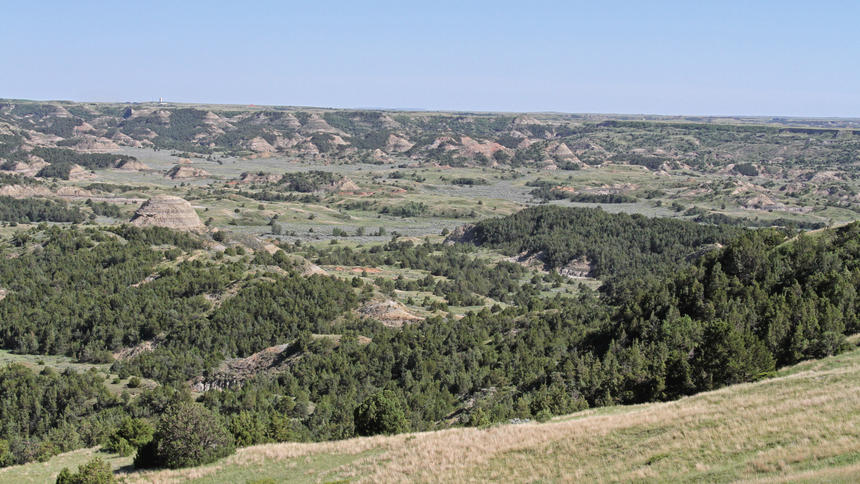MEDORA — Theodore Roosevelt National Park’s top official believes it could be a big year for the western North Dakota people’s playground.
Planning is already underway for the National Park Service’s yearlong centennial celebration, and Park Superintendent Wendy Ross said TRNP is anticipating a sizable boost in visitors thanks to both centennial events and North Dakota Tourism’s nationwide marketing push that highlights the park.
“The centennial is just big,” Ross said.
The publicity push, featuring actor and Minot native Josh Duhamel, includes TV commercials filmed in the park’s South Unit near Medora last summer that are now beginning to air nationally.
“I’m very optimistic,” Ross said. “I think our summer is going to be amazing.”
Boosting visitors
Ross became acting superintendent in November 2014 following Valerie Naylor’s retirement. The “acting” label was dropped last July and she moved into the role permanently.
Her goal is to capture a larger audience and get visitors to the park who may have never been there, or even heard of it, before.
TRNP’s 2015 attendance figures show it had more than 586,000 counted visitors — an increase of about 26,000 people from 2014. However, Ross said those numbers may not be entirely accurate after park officials discovered some of its people counters hadn’t been working for weeks at a time. That glitch has been fixed, she said.
“I’m really concerned about capturing what we get in terms of visitation this year,” Ross said.
Interestingly, Ross said the park is noticing a small demographic shift in who frequents the area.
“We’re just seeing more foreign visitors,” she said. “… We see people who don’t traditionally go to national parks. They’re curious about what it’s all about.”
Ross said she’s looking for opportunities for the park to become relevant to what she calls a “curious generation” beginning to travel more
“The generation that didn’t travel to national parks as children,” she said. “That’s really our opportunity now with all this promotion.”
Being ranked as the No. 5 place in the world to see in 2016 by The New York Times may play into that too, she said.
Ross said park officials worked with the Times’ staff for the piece, so they knew it was coming. But they didn’t realize the park would rank so high on the list, or be mentioned alongside some more exotic locations.
“It’s been great positive press,” she said. “You couldn’t ask for anything better than to be on that list.”
Oil and tourism
Ross said summer tourism now hops back into the front seat of North Dakota’s economy after low oil prices hurt the state’s energy industry. However, the byproduct of low oil prices is lower gas prices low, which benefits the park with both in-state and out-of-state visitors.
“When that starts decreasing, in terms of price, tourism comes up and we see that everywhere, in all national parks,” Ross said.
She said the park’s North Unit, about 15 miles south of still-booming Oil Patch hub Watford City — where the population has increased from 1,600 to around 7,000 in the past five years — has become the park’s “new front door.”
“There are all these countries represented in Watford City that were never there before,” Ross said. “It’s our chance to be relevant to a new generation and a new group of people, to think about that.”
There are challenges up north, however.
The park is working to replace its North Unit Visitors Center, which is currently a collection of portable buildings. But a replacement may be a couple years away from reality, Ross said, because of budgetary concerns. Still, she’s trying to make the North Unit more of a priority.
“It used to be a sleepy backwater, real wilderness experience,” Ross said.
TRMF’s involved in NPS centennial
The Theodore Roosevelt Medora Foundation plans to play a role in the National Park Service Centennial as well, said Justin Fisk, the foundation’s marketing director.
The foundation is sending Roosevelt impersonator Joe Wiegand away from Medora for the entire month of June to travel the country doing presentations and performances to raise awareness about the park.
The Medora Musical will also “very, very likely” have the centennial central to its daily performance, Fisk said.
“They’re writing the show right now and it’s looking cool, and they’re looking for the best way to include the National Park Service Centennial in that,” he said. “It’s pretty exciting.”
Fisk said over the next month, more centennial tie-ins and plans will be finalized between the park service and the foundation.
“With the partnership, you can actually get a lot more done,” Ross said. “You can use community members and partners to fill in some of the nuts-and-bolts gaps, but you can also create those meaningful ties your communities.”




